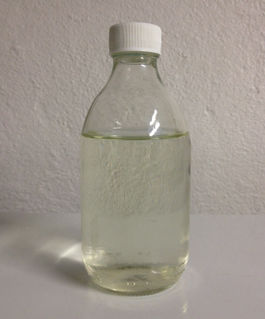Hydrochloric acid
Hydrochloric acid is a clear, colorless, highly pungent aqueous solution of hydrogen chloride (HCl) in water. It is a highly corrosive strong acid, an essential reagent for any amateur chemist.
Contents
Properties
Physical properties
Physical properties of HCl, such as density, pH, boiling and melting point depend on the concentration of HCl in the aqueous solution. They range from those of water at very low concentrations approaching 0% HCl to values for fuming hydrochloric acid at over 40% HCl.
Hydrochloric acid has a constant-boiling azeotrope with water at 20.2% HCl, boiling at 108.6 °C (227 °F).
|
Concentration |
||||||||||
|---|---|---|---|---|---|---|---|---|---|---|
|
kg HCl/kg |
kg HCl/m3 |
Baumé |
kg/L |
mol/dm3 |
mPa·s |
kJ/(kg·K) |
kPa |
°C |
°C | |
|
10% |
104.80 | 6.6 | 1.048 | 2.87 | −0.5 | 1.16 | 3.47 | 1.95 | 103 | −18 |
|
20% |
219.60 | 13 | 1.098 | 6.02 | −0.8 | 1.37 | 2.99 | 1.40 | 108 | −59 |
|
30% |
344.70 | 19 | 1.149 | 9.45 | −1.0 | 1.70 | 2.60 | 2.13 | 90 | −52 |
|
32% |
370.88 | 20 | 1.159 | 10.17 | −1.0 | 1.80 | 2.55 | 3.73 | 84 | −43 |
|
34% |
397.46 | 21 | 1.169 | 10.90 | −1.0 | 1.90 | 2.50 | 7.24 | 71 | −36 |
|
36% |
424.44 | 22 | 1.179 | 11.64 | −1.1 | 1.99 | 2.46 | 14.5 | 61 | −30 |
|
38% |
451.82 | 23 | 1.189 | 12.39 | −1.1 | 2.10 | 2.43 | 28.3 | 48 | −26 |
| The reference temperature and pressure for the above table are 20 °C and 1 atmosphere (101.325 kPa).
Vapour pressure values are taken from the International Critical Tables, and refer to the total vapor pressure of the solution.[1] | ||||||||||
Chemical properties
Hydrochloric acid is generally used as a multi-purpose strong acid, given its relative ease of access and low cost, but it is also the starting point for nearly all chloride salts. Upon the acidification of oxides or hydroxides, water is produced, and carbonates additionally yield carbon dioxide when this occurs. Concentrated hydrochloric acid will react with many metals to produce the metal chloride, often in an oxidized form, as well as flammable hydrogen gas, making this process useful as a source of hydrogen as well.
Addition of hydrochloric acid to potent oxidizers, such as sodium hypochlorite, potassium permanganate, or manganese dioxide, yields chlorine gas, allowing for direct preparation of chlorine for immediate use.
Hydrochloric acid is the most common acid used in titrations, given that it fully dissociates in water and maintains its concentration well over time.
Sources and purification
Hydrochloric acid is commonly available at hardware, paint, and flooring stores, often under the name "muriatic acid", for cleaning concrete, in various concentrations. This source often contains a fair amount of iron(III) chloride. For certain uses, as in PCB etchant production, the impurity does not affect the application. However, it is possible to purify crude hydrochloric acid for other purposes using the two-container technique.
Hydrochloric acid can also be purchased from chemical suppliers
Preparation
One way of synthesizing HCl is to react a mixture of sodium chloride and sodium bisulfate, or sulfuric acid. The mixture is heated and the resultant hydrogen chloride gas is then bubbled through a solution of cold distilled water to produce hydrochloric acid.[2]
- NaHSO4 + NaCl → HCl + Na2SO4
Hydrochloric acid is also produced when covalent chlorides react with water, like acetyl chloride, sulfur/phosphorus chlorides or sulfuryl/thionyl chloride. In general, this route is not very cost effective at producing significant amounts of HCl.
The molarity of the acid then can then be determined by titration or set using azeotropic distillation at ~20.2% (w/v) at standard temperature and pressure.[3]
To learn more, read the article Glauber's hydrochloric acid synthesis.
Handling
Safety
Hydrochloric acid is mostly non-toxic - it only consists of the hydronium ion and the chloride ion. However, it is highly corrosive in high concentrations, and this is the main danger of handling the substance.
Concentrated hydrochloric acid (fuming hydrochloric acid) forms acidic mists. Both the mist and the solution have a corrosive effect on human tissue, so ventilation and protective clothing are highly recommended. Upon mixing hydrochloric acid with common oxidizing chemicals, such as sodium hypochlorite, manganese dioxide, or potassium permanganate (KMnO4), the toxic gas chlorine is produced.
- NaClO + 2 HCl → H2O + NaCl + Cl2
- 2 KMnO4 + 16 HCl → 2 MnCl2 + 8 H2O + 2 KCl + 5 Cl2
While hydrochloric acid is one of the less dangerous strong acids (it is not oxidizing like nitric acid, not dehydrating like sulfuric acid), nevertheless, personal protective equipment such as rubber or PVC gloves, protective eye goggles, and chemical-resistant clothing and shoes are used to minimize risks when handling hydrochloric acid. Hydrochloric acid is a DEA List II chemical.
Storage
Diluted HCl can be stored in glass or plastic bottles, as it gives off very little fumes, though it's recommended that the acid bottle should not be stored near objects made of iron or any other materials susceptible to chloride corrosion.
Concentrated HCl should only be stored in glass bottles in special acid cabinets, as the acidic fumes are notorious for escaping and will corrode nearly everything.
Disposal
Hydrochloric acid should not be dumped down the drain or in the nature, as it it may corrode the sewage system and it is deadly to small animals. It's best to neutralize it first. Calcium carbonate or hydroxide are good neutralizing agent, as well as baking soda. Very low concentrations of the acid are permissible for MOST drains in the United States.
References
- ↑ http://en.wikipedia.org/wiki/Hydrochloric_acid
- ↑ https://www.youtube.com/watch?v=YGjd7xxTuZw
- ↑ http://www.akersolutions.com/Documents/PandC/Mining%20and%20metals/Hydrochloric%20Acid%20Concentration.pdf
